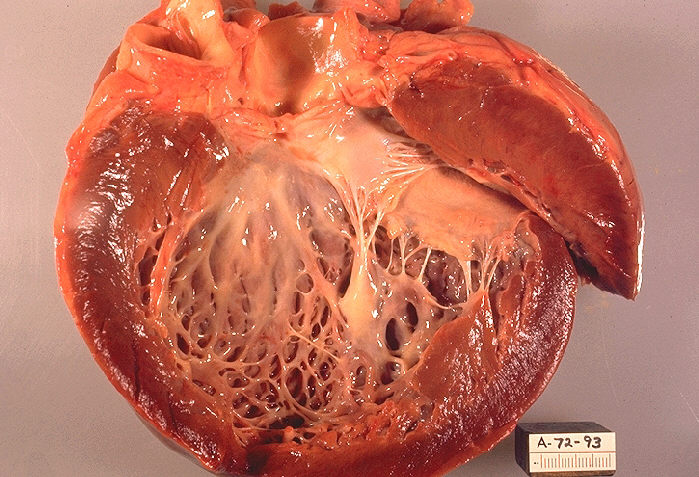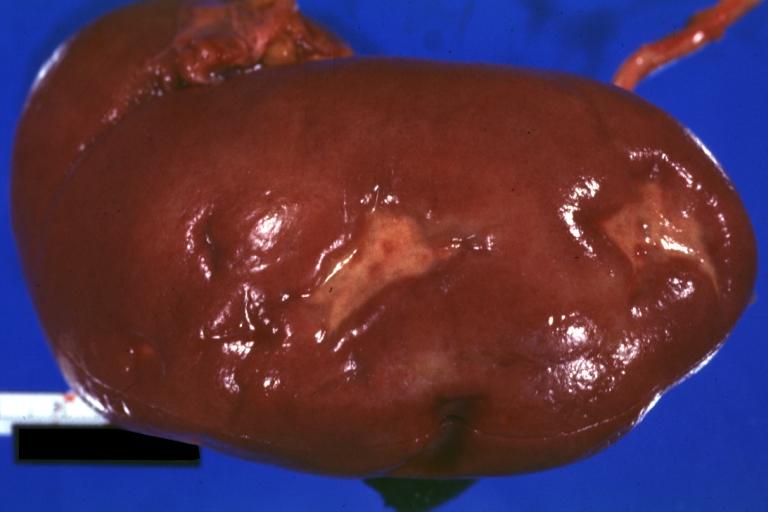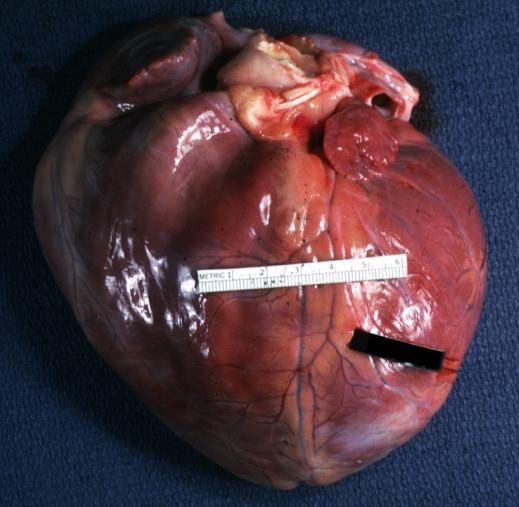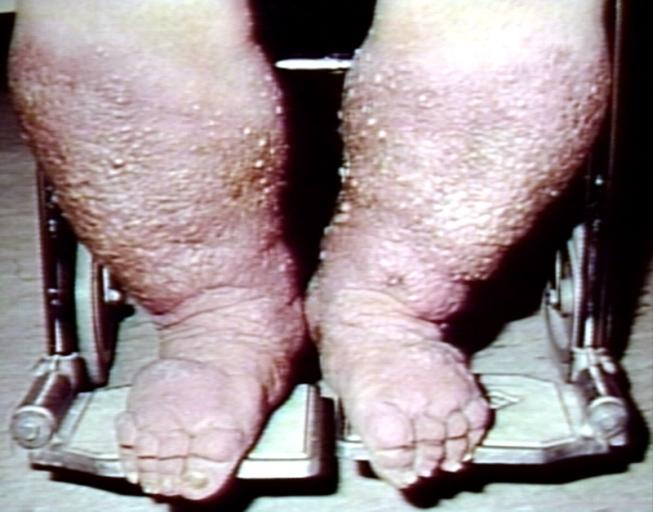Cardiomyopathy
| Cardiomyopathy | |
 | |
|---|---|
| Opened left ventricle of heart shows a thickened, dilated left ventricle with subendocardial fibrosis manifested as increased whiteness of endocardium {Autopsy findings}. Image courtesy of Professor Peter Anderson DVM PhD and published with permission © PEIR, University of Alabama at Birmingham, Department of Pathology | |
| ICD-10 | I42.0 |
| ICD-9 | 425.4 |
| DiseasesDB | 2137 |
| MeSH | D009202 |
|
WikiDoc Resources for Cardiomyopathy |
|
Articles |
|---|
|
Most recent articles on Cardiomyopathy Most cited articles on Cardiomyopathy |
|
Media |
|
Powerpoint slides on Cardiomyopathy |
|
Evidence Based Medicine |
|
Clinical Trials |
|
Ongoing Trials on Cardiomyopathy at Clinical Trials.gov Trial results on Cardiomyopathy Clinical Trials on Cardiomyopathy at Google
|
|
Guidelines / Policies / Govt |
|
US National Guidelines Clearinghouse on Cardiomyopathy NICE Guidance on Cardiomyopathy
|
|
Books |
|
News |
|
Commentary |
|
Definitions |
|
Patient Resources / Community |
|
Patient resources on Cardiomyopathy Discussion groups on Cardiomyopathy Patient Handouts on Cardiomyopathy Directions to Hospitals Treating Cardiomyopathy Risk calculators and risk factors for Cardiomyopathy
|
|
Healthcare Provider Resources |
|
Causes & Risk Factors for Cardiomyopathy |
|
Continuing Medical Education (CME) |
|
International |
|
|
|
Business |
|
Experimental / Informatics |
| Cardiology Network |
 Discuss Cardiomyopathy further in the WikiDoc Cardiology Network |
| Adult Congenital |
|---|
| Biomarkers |
| Cardiac Rehabilitation |
| Congestive Heart Failure |
| CT Angiography |
| Echocardiography |
| Electrophysiology |
| Cardiology General |
| Genetics |
| Health Economics |
| Hypertension |
| Interventional Cardiology |
| MRI |
| Nuclear Cardiology |
| Peripheral Arterial Disease |
| Prevention |
| Public Policy |
| Pulmonary Embolism |
| Stable Angina |
| Valvular Heart Disease |
| Vascular Medicine |
Editor-In-Chief: C. Michael Gibson, M.S., M.D. [1]
Associate Editor-In-Chief: Cafer Zorkun, M.D., Ph.D. [2]
Please Take Over This Page and Apply to be Editor-In-Chief for this topic: There can be one or more than one Editor-In-Chief. You may also apply to be an Associate Editor-In-Chief of one of the subtopics below. Please mail us [3] to indicate your interest in serving either as an Editor-In-Chief of the entire topic or as an Associate Editor-In-Chief for a subtopic. Please be sure to attach your CV and or biographical sketch.
Overview
Cardiomyopathy, which literally means "heart muscle disease", is the deterioration of the function of the myocardium (i.e., the actual heart muscle) for any reason. People with cardiomyopathy are often at risk of arrhythmia or sudden cardiac death or both.[1]
Cardiomyopathies can generally be categorized into two groups, based on World Health Organization guidelines: extrinsic cardiomyopathies and intrinsic cardiomyopathies.[2]
In general definition;
Cardiomyopathies are myocardial diseases that independent of:
- Congenital Heart Disease
- Pericardial Disease
- Pulmonary hypertension / Systemic hypertension
- Heart valve disease
Extrinsic cardiomyopathies
These are cardiomyopathies where the primary pathology is outside the myocardium itself. Most cardiomyopathies are extrinsic, because by far the most common cause of a cardiomyopathy is ischemia. The World Health Organization calls these specific cardiomyopathies:[2]
- Alcoholic cardiomyopathy
- Coronary Artery Disease
- Congenital Heart Disease
- Hypophosphatemia mediated myonecrosis as part of the refeeding syndrome
- Inflammatory cardiomyopathy
- Ischemic cardiomyopathy
- Hypertensive cardiomyopathy
- Nutritional Diseases
- Systemic metabolic disease
- Valvular cardiomyopathy
Ischemic cardiomyopathy
Ischemic cardiomyopathy is a weakness in the muscle of the heart due to inadequate oxygen delivery to the myocardium with coronary artery disease being the most common cause. Anemia and sleep apnea are relatively common conditions that can contribute to ischemic myocardium and hyperthyroidism can cause a 'relative' ischemia secondary to high output heart failure. Individuals with ischemic cardiomyopathy typically have a history of myocardial infarction (heart attack), although longstanding ischemia can cause enough damage to the myocardium to precipitate a clinically significant cardiomyopathy even in the absence of myocardial infarction. In a typical presentation, the area of the heart affected by a myocardial infarction will initially become necrotic as it dies, and will then be replaced by scar tissue (fibrosis). This fibrotic tissue is akinetic; it is no longer muscle and cannot contribute to the heart's function as a pump. If the akinetic region of the heart is substantial enough, the affected side of the heart (i.e. the left or right side) will go into failure, and this failure is the functional result of an ischemic cardiomyopathy.
Cardiomyopathy due to systemic diseases
Many diseases can result in cardiomyopathy. These include diseases like hemochromatosis, (an abnormal accumulation of iron in the liver and other organs), amyloidosis (an abnormal accumulation of the amyloid protein), diabetes, hyperthyroidism, lysosomal storage diseases and the muscular dystrophies.
Intrinsic cardiomyopathies
An intrinsic cardiomyopathy is weakness in the muscle of the heart that is not due to an identifiable external cause. To make a diagnosis of an intrinsic cardiomyopathy, significant coronary artery disease should be ruled out (amongst other things). The term intrinsic cardiomyopathy does not describe the specific etiology of weakened heart muscle. The intrinsic cardiomyopathies are a mixed-bag of disease states, each with their own causes.
Intrinsic cardiomyopathy has a number of causes including drug and alcohol toxicity, certain infections (including Hepatitis C), and various genetic and idiopathic (i.e., unknown) causes.
Intrinsic cardiomyopathies are generally classified into four types,[2][3] but additional types are also recognized:
- Dilated cardiomyopathy (DCM), the most common form, and one of the leading indications for heart transplantation. In DCM the heart (especially the left ventricle) is enlarged and the pumping function is diminished. Approximately 40% of cases are familial, but the genetics are poorly understood compared with HCM. In some cases it manifests as peripartum cardiomyopathy, and in other cases it may be associated with alcoholism.
- Hypertrophic cardiomyopathy (HCM or HOCM), a genetic disorder caused by various mutations in genes encoding sarcomeric proteins. In HCM the heart muscle is thickened, which can obstruct blood flow and prevent the heart from functioning properly.
- Arrhythmogenic right ventricular cardiomyopathy (ARVC) arises from an electrical disturbance of the heart in which heart muscle is replaced by fibrous scar tissue. The right ventricle is generally most affected.
- Restrictive cardiomyopathy (RCM) is an uncommon cardiomyopathy. The walls of the ventricles are stiff, but may not be thickened, and resist the normal filling of the heart with blood. A rare form of restrictive cardiomyopathy is the obliterative cardiomyopathy, seen in the hypereosinophilic syndrome. In this type of cardiomyopathy, the myocardium in the apices of the left and right ventricles becomes thickened and fibrotic, causing a decrease in the volumes of the ventricles and a type of restrictive cardiomyopathy.
- Noncompaction cardiomyopathy has been recognized as a separate type since the 1980s. The term refers to a cardiomyopathy where the left ventricle wall has failed to grow properly from birth and has a spongy appearance when viewed during an echocardiogram.
Alternate Detailed Classification Schemes
There are other more detailed classification schemes with a more complete Differential diagnosis as shown below:
Clinical Classification
- DILATED (D):
- Left and/or right ventricular enlargement
- Impaired systolic function
- Congestive heart failure
- Arrhythmias
- Emboli
- RESTRICTIVE (R):
- Endomyocardial scarring or myocardial infiltration resulting in restriction to left and/or right ventricular filling.
- HYPERTROPHIC (H):
- Disproportionate left ventricular hypertrophy
- Typically involving septum more than free wall
- With or without an intraventricular systolic pressure gradient
- Usually of a nondilated left ventricular cavity
- Disproportionate left ventricular hypertrophy
PRIMARY MYOCARDIAL INVOLVEMENT
- Idiopathic (D,R,H)
- Hereditary (D,R,H)
- Eosinophilic Endomyocardial Disease (R)
- Endomyocardial Fibrosis (R)
SECONDARY MYOCARDIAL INVOLVEMENT
- Sensitivity and toxic reactions (Dilated cardiomyopathy)
- Metabolic (Dilated cardiomyopathy)
- Selenium Deficiency
- Hypophosphatemia
- Hypocalcemia
- Thyroid Disease
- Infectious (Dilated cardiomyopathy)
- Familial Storage Disease (Dilated cardiomyopathy, Restrictive cardiomyopathy)
- Connective Tissue Disorders (Dilated cardiomyopathy)
- Infiltrative and Granulomatous (Restrictive cardiomyopathy, Dilated cardiomyopathy)
- Neuromuscular (Dilated cardiomyopathy)
- Other (Dilated cardiomyopathy)
- Uncontrolled Tachycardia
- Right Ventricular Dysplasia
- Peripartum Heart Disease (Dilated cardiomyopathy)
Differential Diagnosis of Causes of Cardiomyopathy
Primary Cardiomyopathies
- Endomyocardial fibrosis
- Eosinophilic endomyocardial disease
- Familial
- Idiopathic
Secondary Cardiomyopathies
- Acromegaly
- Adenoviruses
- Amebiasis
- Amyloidosis
- Angiomas
- Arboviruses
- Ascariasis
- Aspergillosis
- Beta hemolyzing streptococci
- Blastomycosis
- Borrelia burgdorferi
- Brucella
- Cardiac transplant rejection
- Carnitine deficiency
- Chagas Disease
- Coccidioidomycosis
- Coxsackie virus A
- Coxsackie virus B1-B5
- Chronic tachycardia
- Cryptococcosis
- Cushing's Disease
- Cysticercosis
- Cytomegalovirus (CMV)
- Dermatomyositis
- Diabetes Mellitus
- Diptheria
- Drug-induced allergy
- Drugs, toxins
- Echinococcosis
- ECHO viruses (EnteroCytopathogenic Human Orphan viruses)
- Electric shock
- Electrolyte imbalances
- Enterococci
- Epstein-Barr Virus (EBV)
- Fabry's Disease
- Filariasis
- Flavivirus
- Friedrich's Ataxia
- Gangliosidosis
- Gaucher's Disease
- Giant Cell Myocarditis
- Glycogen storage diseases
- Gout
- Hand-Schuller-Christian Syndrome
- Heatstroke
- Hemochromatosis
- Hepatitis
- Histoplasmosis
- HIV
- Hunter's Syndrome
- Hurler's Syndrome
- Hyperparathyroidism
- Hyperthyroidism
- Hypothermia
- Hypothyroidism
- Idiopathic
- Influenza
- Irradiation
- Kawasaki's Disease
- Leishmaniasis
- Leptospirosis
- Leukemia
- Lightening strike
- Lyme Disease
- Malaria
- Measles
- Mucopolysaccharidosis
- Mumps
- Muscular Dystrophy
- Myotonic Dystrophy
- Myxomas
- Neimann-Pick Disease
- Niacin deficiency
- Obesity
- Oral candidiasis
- Oxalosis
- Pertussis
- Pheochromocytoma
- Polio
- Polyarteritis Nodosa
- Polycythemic Vera
- Porphyria
- Postpartal cardiomyopathy
- Psittacosis
- Q Fever
- Rabies
- Refsum's Disease
- Rhabdomyomas
- Rheumatic Fever
- Rheumatoid Arthritis
- Rocky Mountain Spotted Fever
- Sacrosporidiosis
- Sarcoidosis
- Sarcomas
- Schistosomiasis
- Scleroderma
- Selenium deficiency
- Sickle Cell Anemia
- Staphylococcus
- Syphilis
- Systemic Lupus Erythematosus
- Tetanus
- Thrombotic Thrombocytopenic Purpura
- Toxoplasmosis
- Trauma
- Trichinosis
- Tuberculosis
- Typhoid Fever
- Uremia
- Varicella-zoster virus
- Vitamin B deficiency
- Vitamin C deficiency
- Vitamin D overdose
- Whipple's Disease
Treatment
Treatment depends on the type of cardiomyopathy, but may include medication, implanted pacemakers, defribillators, or ventricular assist devices (LVADs), or ablation. The goal of treatment is often symptom relief, and some patients may eventually require a heart transplant. Treatment of cardiomyopathy (and other heart diseases) using alternative methods such as stem cell therapy is commercially available but is not supported by convincing evidence.
Genetic causes of cardiomyopathy
| Phenotype | Inheritance pattern | Chromosomal locus | Gene | Protein | Skeletal myopathy |
|---|---|---|---|---|---|
| Dilated cardiomyopathy | X-linked | Xp21 | dystrophin | Dystrophin | Duchenne / Becker muscular dystrophy |
| X-linked | Xq28 | G4.5 | Tafazzin | Barth syndrome | |
| Autosomal dominant | 15q14 | actin | Actin | Nemaline myopathy | |
| 2q35 | desmin | Desmin | Desmin myopathy | ||
| 5q33 | δ-sarcoglycan | δ-sarcoglycan | Limb girdle muscular dystrophy 2F | ||
| 1q32 | Troponin T | Troponin T | |||
| 14q11 | β-myosin heavy chain | β-myosin heavy chain | |||
| 15q2 | α-tropomyosin | α-tropomyosin | Nemaline myopathy | ||
| Midna | Mitochondrial respiratory chain | Mitochondrial respiratory chain | Mitochondrial myopathy | ||
| Dilated cardiomyopathy with conduction disease | Autosomal dominant | 1q21 | lamin A/C | Lamin A/C | Emery-Dreifuss muscular dystrophy |
| Hypertrophic cardiomyopathy | Autosomal dominant | 14q11 | β-myosin heavy chain | β-myosin heavy chain | |
| 14q11 | β-myosin heavy chain | β-myosin heavy chain | |||
| 1q32 | Troponin T | Troponin T | |||
| 12q23 | Troponin T | Troponin T | |||
| 15q2 | α-tropomyosin | α-tropomyosin | Nemaline myopathy | ||
| 11q11 | myosin-binding protein C | myosin-binding protein C | |||
| 3p21 | myosin essential light chain | myosin essential light chain | |||
| 3p21 | myosin regulatory light chain | myosin regulatory light chain | |||
| 2p31 | titin | Titin | |||
| Hypertrophic cardiomyopathy with Wolf-Parkinson-White syndrome | 7q3 | AMPK | AMPK | ||
| MIDINA | Mitochondrial respiratory chain | Mitochondrial respiratory chain | Mitochondrial myopathy | ||
| Left ventricular noncompaction | X-linked | Xq28 | G4.5 | Tafazzin | Barth syndrome |
| Autosomal dominant | 18q12 | α-dystrobrevin | α-dystrobrevin | Muscular dystrophy |
Table from article *"The Failing Heart". Nature. June 15, 2007
Gross Pathological Findings
-
Cardiomyopathy: Gross excellent view of mitral valve from left atrium anterior leaflet appears to balloon a bit into the atrium
-
Cardiomyopathy: Gross excellent view of mitral and tricuspid valves from atria, appear normal anatomy.
-
Cardiomyopathy: Gross apical slice of left and right ventricles concentric hypertrophy with cavitary obliteration sudden unexpected death obstructive cardiomyopathy
-
Dilated Cardiomyopathy: Gross natural color close-up view of heart surgically removed for a transplantation shows aortic valve and anterior leaflet of mitral valve with cholesterol deposits endocardium of left ventricle is diffusely thickened
-
Cardiomyopathy: Gross montage of ventricular slices showing hypertrophy and about normal ventricular lumen size a hypertrophic non-dilated cardiomyopathy
-
Cardiomyopathy: Gross ventricular slices hypertrophy and extensive myocardial fibrosis a unique case of global fiber disarray with atrophy and fibrosis
-
Cardiomyopathy: Gross close up view of a ventricle slice
-
Cardiomyopathy: Gross excellent ventricular slice with hypertrophy and fibrosis a unique case of global fiber disarray with hypertrophy then atrophy and then fibrosis
-
Cardiomyopathy: Gross external view of globular heart with patchy fibrosis seen through epicardium
-
Cardiomyopathy: Gross interventricular septum showing asymmetrical hypertrophy in posterior septum
-
Cardiomyopathy: Gross hypertrophic cardiomyopathy obstructive excellent section through left ventricle outlet to show subvalvular narrowing case of sudden death in a 27 yo male playing basketball no history of disease
-
Cardiomyopathy: Gross obstructive cardiomyopathy showing aorta outflow tract with marked endocardial thickening mitral valve appears normal (Same case as previous one)
-
Cardiomyopathy: Gross excellent view of mitral valve atrial surface showing thickening which is fibrous in body of valve and myxoid at area of free margin changes presumed secondary to insufficiency due to anterior motion
-
Cardiomyopathy: Gross dilated left ventricle with marked endocardial thickening this is what has been called adult fibroelastosis
-
Dilated Cardiomyopathy: Gross good example huge dilated left ventricle
-
Dilated Cardiomyopathy: Gross dilated left ventricle with marked endocardial sclerosis (an excellent example)
-
Cardiomyopathy: Gross intact globular shaped heart
-
Dilated Cardiomyopathy: Gross opened left ventricle dilated with endocardial thickening good example
-
Cardiomyopathy: Gross globular heart external view 10 year old girl with sickle cell anemia
-
Cardiomyopathy: Gross horizontal sections of ventricles dilation type 10 year old girl with sickle cell anemia
-
Cardiomyopathy: Intermediate between hypertrophic and dilated
-
Cardiomyopathy Asymmetrical Septal Hypertrophy
-
Dilated Cardiomyopathy: Gross opened globular left ventricle natural color (very good example)
-
Diabetic Cardiomyopathy: Gross natural color moderately hypertrophied heart shown in horizontal section hyperemic subendocardium has no microscopic lesion long standing type I diabetic patient, no significant coronary artery lesions, congestive heart failure
-
Brain: Infarct: Healing large MCA and PICA probably embolic 64 year old female chronic obstructive pulmonary disease and cardiomyopathy with atrial fibrillation
-
Kidney: Infarct Remote: Gross external view with capsule removed two old and very typical infarct scars 27yobf with dilated cardiomyopathy
-
Dilated Cardiomyopathy: Gross natural color external view globular heart 500 gm 24yo female seven pregnancies
-
Excessive pedal edema due to right heart failure in a patient with hypertrophic cardiomyopathy (due to functional aortic stenosis from narrow outflow tract)
Microscopic Pathological Findings
-
Cardiomyopathy: Micro H&E high mag excellent example myofiber disarray
-
Cardiomyopathy: Micro H&E low mag interventricular septum at junction of normal myofiber orientation with asymmetrical hypertrophy (an excellent example)
-
Cardiomyopathy: Micro trichrome low mag bizarre vacuolated fibers with disarray and focal fibrosis excellent low mag epicardial surface
-
Alcoholic Cardiomyopathy: Micro plastic section lipid in perinuclear area loss of myofibrils
References
- ↑ Kasper, Denis L.; et al. (2005). Harrison's Principles of Internal Medicine, 16th edn. McGraw-Hill. ISBN 0-07-139140-1.
- ↑ 2.0 2.1 2.2 Richardson, P.; et al. (1996). "Report of the 1995 World Health Organization/International Society and Federation of Cardiology Task Force on the Definition and Classification of cardiomyopathies". Circulation. 93 (5): 841–2. PMID 8598070. (Full text)
- ↑ Cardiomyopathy Association. "About cardiomyopathy". September 28, 2006
External links
- The Cardiomyopathy Association
- Cardiomyopathy information from Seattle Children's Hospital Heart Center
- Information from the Stanford Hypertrophic Cardiomyopathy Center
- Cardiomyopathy-related antibodies
Additional Reading
- Moss and Adams' Heart Disease in Infants, Children, and Adolescents Hugh D. Allen, Arthur J. Moss, David J. Driscoll, Forrest H. Adams, Timothy F. Feltes, Robert E. Shaddy, 2007 ISBN 0781786843
- Hurst's the Heart, Fuster V, 12th ed. 2008, ISBN 978-0-07-149928-6
- Willerson JT, Cardiovascular Medicine, 3rd ed., 2007, ISBN 978-1-84628-188-4
Template:SIB de:Kardiomyopathie nl:Cardiomyopathie no:Kardiomyopati simple:Cardiomyopathy sr:Кардиомиопатија sv:Hjärtmuskelsjukdom































